All My Friends Are Fungi
Changes
I could feel that something was off before I broke the tree line. It’s the same feeling I get when I come home after being gone all day, and before I enter the house I know someone decided to move one of my “messy” projects. That annoying dread that I might have to start over. I wonder if they looked out over the field and saw a mess. If that is why they decided to cut it all down and cart most of it away.
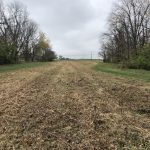
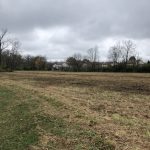
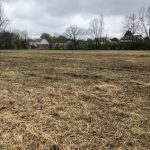
![IMG_3493[1]](https://ecologyblog.press.hollins.edu/wp-content/uploads/sites/43/2020/10/IMG_34931-225x300.jpg)
![IMG_3495[1]](https://ecologyblog.press.hollins.edu/wp-content/uploads/sites/43/2020/10/IMG_34951-225x300.jpg)
Today, I sat facing west.This is the direction where the field used to be. I knew it would happen eventually. This is a repeating pattern that every year they let it grow just to cut it down. My question is where did the grasshoppers go? Do they hunker down like bees and wasps do for the winter? It is much more quiet without them and a bit ominous. The sky is slate gray and stagnant. There are no discernible clouds, just a blanket sky with no sun. It’s a warning: “Just because it isn’t raining now doesn’t mean it won’t be raining in ten minutes.” Ohioans joke that the weather is unpredictable and forever changing. That’s no joke.
It’s crazy how the brain chooses what to perceive. While I was recording details in my journal, I neglected to observe the bird calls from the trees. I am pleased to report that the nests I spotted last time are still intact. That, and the bird calls, are evidence that they are in this area even if I cannot see them.
What Stayed the Same?
The walnuts have been steadily troddened deeper into the earth by human and animal foot traffic. My tree stump is as stalwart as ever sporting its green moss like a fine fur. With the loss of the field, comes the loss of the Canadian Goldenrod I had been observing. This was the most drastic change. As I have stated prior, I fear that the Goldenrod isn’t the only thing that has been lost to me. I wasn’t able to find a grasshopper to observe and see if they are the same species as the one I photographed and identified as being the red-legged grasshopper. Nor, have I stumbled upon any wooly bear caterpillars. Who is supposed to predict winter now?
Haunted Anthills
I did find some new interesting features at my sit-spot that I am entirely ecstatic to share. To start I found a series of what looks to be anthills! Without thinking about it, I spent an embarrassing amount of time watching them to see if an ant would peak its head out or come back to its colony. I believe it was too wet of a day for that much activity. However, while I gazed at those impressive sandy-looking piles, I grew curious as to what types of species of ants we have here in southern Ohio.
Well, it turns out there are five types that are very common. They are as follows: Little Black Ants, Pavement Ants, Carpenter Ants, Odorous House Ants, and Red Fire Ants.
Red Fire Ants are an invasive species that have taken over. They can be extremely aggressive when bothered and sting. Their sting can be very painful and have been described as a burning sensation. Those stung will have varying responses dependent upon their sensitivity. Some people will have itching and fluid-filled pustules, but others may need to seek out emergency care to treat chest pain and difficulty breathing.

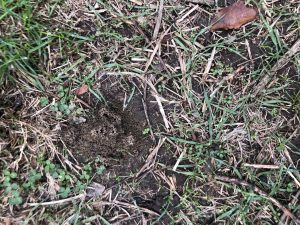
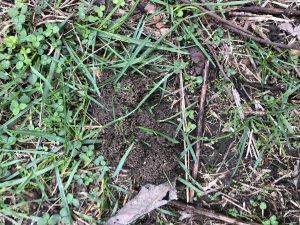
This ant species loves sandy sandy or heavy clay soil and will build their nests in the sun, avoiding shady areas. More interesting, they are omnivorous. Yes, that’s right, these ants eat animals and plants and tend to not discriminate between the living and the dead. This is 10/10 spooky for me. While I have no proof that the anthills I found belong to these guys, it serves as a good reminder that not every creature can be made friends with.
New Friends
I did end up taking home one organism, however. I just couldn’t help myself! They were just standing there all cute, round, white… releasing spores. Mushrooms, I found mushrooms! These guys are superheroes of the environment as well as superfoods. WARNING: Not all mushrooms are edible and I do not recommend eating mushrooms you find in the wild.
Mushrooms are important because as decomposers they cycle nutrients in the ecosystem. There are roughly 1.5 million estimated species of mushroom but scientists only know what 5% of those species do to interact with the environment. Still, these organisms receive high acclaim. I wish I could write 5% of my paper and still get an A.
We can tell the difference between species of macrofungi based on their fruiting bodies, the mushroom. However, the mushroom is only the tip of the iceberg. Most of the fungi is in the soil in the form of hyphae collectively called mycelium. Hyphae are the threadlike structures used for vegetative growth in fungi. The mycelium is actually used as a highway of information between plants in that area. They link the roots of different plants so they can share nutrients or assassinate an unwanted plant. It is estimated that 90% of land plants share this type of mutually beneficial relationship with fungi, known as mycorrhizal associations. These associations can actually boost the immune system of “host” plants and can even help plants grow. What a fun-guy, am I right?
I decided to take some of these mushrooms home for one of my “messy” projects. One of the cool things about mushrooms is that some have caps with gills underneath where their spores are. Spores can be light, dark, brown, yellow, etc. With these mushrooms, I wanted to make spore prints. Spore prints can be used to help discern between two types of mushrooms, but also make very pretty art. If you want to know how to make them, I linked a video in this blog showing what I did!
With everything happening in the world right now, it is necessary to take a moment to ground yourself. Shut the TV off, put the phone away, and simply exist for a moment. By focusing on just one part of the world we can learn a lot, but also miss a lot too. I was devastated by the drastic change to my sit-spot, but maybe I never would have found those mushrooms!
References
Fleming, N. (2014). Plants talk to each other using an internet of fungus. Bbc.Com. http://www.bbc.com/earth/story/20141111-plants-have-a-hidden-internet
National Pesticide Information Center. (2020, September 18). Fire Ants. Npic.Orst.Edu. http://npic.orst.edu/pest/fireant.html
Service, F., Ostry, M., Anderson, N., & O'brien, J. (2010). United States Department of Agriculture Field Guide to Common Macrofungi in Eastern Forests and Their Ecosystem Functions. https://www.fs.fed.us/nrs/pubs/gtr/gtr_nrs79.pdf
Summit County Pest Control. (n.d.). Five Most Common Ant Species In Ohio. Summit County Pest Control. Retrieved October 29, 2020, from https://summitcountypestcontrol.com/blog/five-most-common-ants-in-ohio.html


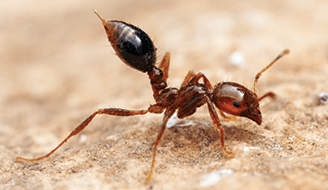
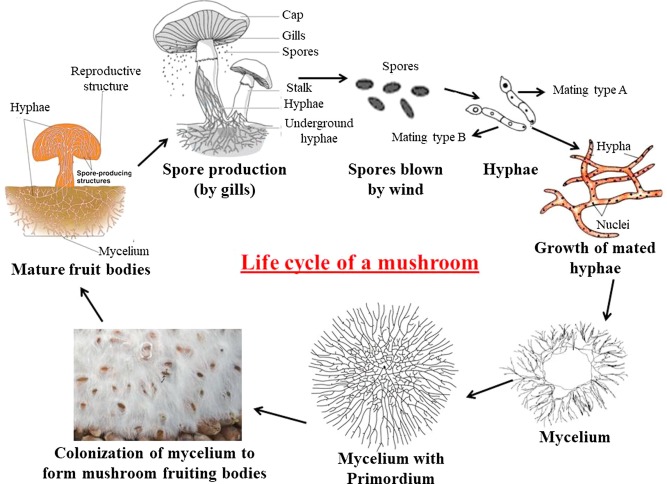
Love the video on spore prints! I can’t wait to try this out
It’s honestly so fun and simple and if you have little ones in your life, they love to make these!
THIS IS such amazing and awesome work Kyra – thank you for sharing your thoughts and your space! Your video was excellent – so wonderful you included that as well! I am going to suggest other folks come visit this blog – well done!